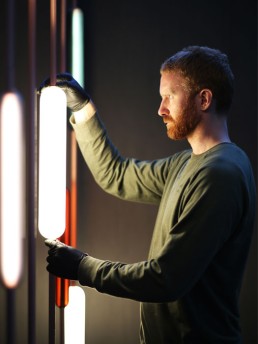
Australasia design report
Acting Editor Sarah Cullen sits down with product designer Edward Linacre of Copper to find out more about his lighting practice, the design market in Australia and the current challenges it faces.
Edward Linacre is the Co-Founder of Melbourne-based Copper, a product design studio that specialises in illuminated artworks, contemporary luminaires, limited edition lighting fixtures and installations, both large and small-scale.
“I am an Industrial Designer and Artist who trained and worked in Australia and Germany before starting my own studio, Copper, in 2013, with Industrial Designer Viktor Legin,” he tells darc. “Initially we were operating as a product design consultancy across various industries, including Medical Device design where we authored international patents. However, our focus was drawn to our artform-based side project, creating sculptural lighting. The art of illumination to me was the amalgamation of technical lighting engineering and my passion for sculpture. My works were born through no commercial aspiration, but for visual and emotional pleasure.”
Since working within lighting, Linacre has observed some changes within Australia’s lighting industry, noting in particular the move “towards site-specific lighting solutions, in harmony with their environments, and a movement away from the traditional approach of specifying stock lighting products for interiors”. As a result of this, at Copper they have since designed their ranges based on their ability to be customised and personalised to the requirements of the client and the space.
When asked about what makes Australia’s market stand out from the rest, Linacre highlights the geographical impacts that being an isolated continent can have. “We are isolated from the global design community, so we are not as influenced by global trends. As we have far fewer industry lighting and furniture manufacturers than Europe or the US, a boom of small-scale designer maker studios has been underway for the past 10 years,” he says. “We all strive to have our own identity and aim to be distinctive, but overall, we are environmentally sensitive due to our Australian environmental conditions. The design and architecture community in Australia is leading the charge in environmentally focused initiatives, like zero carbon operations, and re-use/recycling of waste product. As the design community is small in the scope of Australia, we are very supportive of each other, and regularly exhibit without peers and competitors. I believe we feel together we are stronger.”
As we will see in the following case studies from Australasia-based designers and manufacturers, the use of natural materials in lighting products is a driving focus in this region. “Natural materials are a strong theme across my industry. Metals, timbers, stones; exploring the beauty of organic materials is a fascination of many. “We also experiment and explore through design and there are some very influential young designers working to encourage research-based outcomes, innovation, and exploration of social, cultural and environmental factors of their work. Through our design education, we are taught to understand the obligations of a product designer to consider all implications of the product we are bringing into the world.”
Aside from this materials-based commonality within the region, Linacre doesn’t believe there are any specific trends occurring within both the product and interior design industry. However, he notes that the lighting designer/maker scene, more specifically in Melbourne, is booming these days. “We are the new New York. We keep each other striving for individualism and experimentation, and support and encourage each other to succeed and push the limits of our artform,” he explains. “We help each other with parts, with providing advice to the younger studios – it is really a beautiful community.
“We don’t focus on trends, but I can tell you our glass work (the Flask System) is doing very well, primarily I believe due to its ability to be personalised and customised to suit the requirements of the client or space.”
Some of the most note-worthy designers in Australia at the moment, according to Linacre, include Christopher Boots, Coco Flip, Volker Haug, Ross Gardam, Articolo, Nightworks, Adesignstudio, BTD, and Porcelain Bear, all because “they are bloody brilliant”.
One of the biggest problems the Australian design market is facing currently is one many will find relatable – counterfeit products. Linacre adds further: “As with any market, we face the imports of cheap replicas, counterfeit products and rip-offs, even of our own Australian products. But the public is learning the faults of fast furniture and lighting, and we see a resurgence of local manufacturing in Australia, and a growth of my industry in the past 10 years.”
Looking ahead, Linacre believes Australia will continue driving forward the site-specific lighting outcomes and encouraging less mass production of single items that may not have the effect required by the environment. “We also are involved in a biodegradable material revolution of sorts in Australia. Our contribution is Mycelium, [a multidisciplinary creative studio and co-working hub that seeks to develop community and improve our environment through design thinking and the creative process]. We have created seating, lighting shades, and various other 100% biodegradable products, and it’s only the beginning.”



